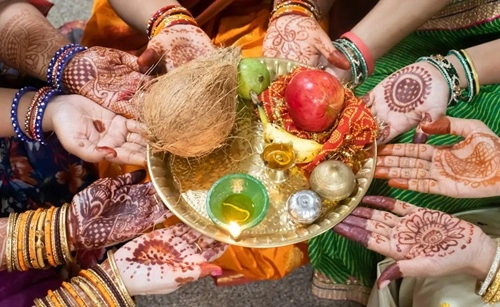Teej is a vibrant and deeply meaningful festival celebrated by Hindu women across many parts of India and Nepal. It marks joy, devotion and the monsoon’s fresh greenery, and is dedicated to the divine relationship between Shiva and Parvati. Married women observe this day to pray for the long life, welfare and happiness of their husbands, while unmarried girls pray for a good life-partner. The festival also symbolises nature’s renewal — the arrival of rains, lush green landscapes and new beginnings.
“Teej” collectively refers to several festivals — most prominently Hariyali Teej (Green Teej), Kajari Teej, and Hartalika Teej — each observed at different times in the monsoon season, but all embodying the devotion of women for marital bliss and harmony.
In this article we’ll focus on Hartalika Teej 2026, looking at its date, puja shubh muhurat timings, significance and how one can observe it meaningfully.

Teej Date & Puja Shubh Muhurat for 2026
For the year 2026, Hartalika Teej falls on Monday, 14 September 2026 (for New Delhi/NCT & much of North India).
Key timing details include:
- Tritiya Tithi begins on Sunday, 13 September 2026 at 07:08 AM.
- The tithi ends on Monday, 14 September 2026 at 07:06 AM.
- The “Pratah Kala” or early morning muhurat for the puja is noted as 06:05 AM to 07:06 AM on 14 September 2026.
Thus, women observing Hartalika Teej in 2026 should prepare to begin their puja early on Monday morning during the above-window, aligning with the most auspicious phase of the Tritiya tithi.
Significance of Hartalika Teej
Mythological background
The name “Hartalika” is derived from the Sanskrit words “harit” (abducted) and “aalika” (female friend). The legend goes that Goddess Parvati’s friends helped her to be abducted (in a friendly way) so she could escape her father’s wish and seek Lord Shiva as her husband. In the forest, Parvati performed austerities and offered prayers to Shiva. Shiva, pleased by her devotion, accepted her as his spouse. Since then, the third day (Tritiya) of the bright half (shukla paksha) of the Hindu month of Bhadrapada is celebrated as Hartalika Teej.
Thus the festival symbolises the power of devotion, marriage, and the union of Parvati and Shiva. Women emulate Parvati’s dedication by observing the fast, praying for their husband’s long life, and seeking marital harmony.
Cultural and social meaning
- Married women observe a nirjala (without water) or ek-bhojan (single meal) fast for the well-being of their husbands and family.
- Unmarried girls pray for a good partner and performance of suitable rituals, often hoping to be blessed with a happy married life.
- The festival invites communal gathering, traditional dressing (often red or green for married women), and renewal of social bonds.
- From an environmental perspective, the timing in late monsoon (Bhadrapada) highlights the lushness of nature, making it a celebration of fertility and abundance.
- The puja and rituals reinforce values of respect, service, gratitude and familial responsibility.
Why it matters
- For families, the festival becomes a day of reaffirmation: husbands recognise the devotion of their wives, children see the commitment of their mothers, and sisters join in the community spirit.
- For women, it is a day of spiritual strength, self-discipline (through fast), and cultural affirmation of their role not only as wives but as key guardians of familial harmony.
- It gives a cultural rhythm to the monsoon season — as rains nourish the land, Teej nourishes relationships.
How to Observe Hartalika Teej – Ritual Highlights
- Preparations & cleaning: The day before, women clean the house, prepare the puja area, arrange traditional sweets, fruits, new clothes, bangles, mehendi, and decorative items.
- Fast: On the day of Hartalika Teej, the fast typically starts very early and is maintained till the next morning. Some observe without food and water, others allow a light meal depending on tradition.
- Puja early morning: Since the muhurat is about 06:05 AM–07:06 AM on 14 Sept 2026, women should gather at the puja spot by that time, light the lamp (diya), offer flowers, fruits, sweets, and worship Shiva-Parvati.
- Story/Katha: The mythological story of Parvati’s devotion is recounted; women may listen to it collectively.
- Breaking the fast: After the puja is complete and the tithi ends, the fast is broken, sweets and fruits are shared with family.
- Dress & celebration: Often the festivity includes wearing red/green, applying henna, jewellery, visiting friends/family, sharing gifts and sweets.
- Community aspect: In many places large gatherings occur at temples or community halls where many women perform the vrat together, fostering solidarity.
Practical Tips for 2026
- Set your alarm early on 14 September 2026 and ensure all puja items are ready the previous evening.
- Since the muhurat is short (~one hour early morning), try to complete essential rituals during it.
- Plan a modest meal for after the fast — fruits, light sweets, seasonal vegetarian dishes.
- If you’re unmarried and observing, use the day to reflect on values of marriage, partnership, and personal growth, not just ritual alone.
- For married women, involve your husband and family in the observance — the day reinforces togetherness and mutual respect.
- Use the monsoon backdrop (lush greenery, rain-washed home) to bring freshness to your celebrations: maybe decorate the house with fresh leaves/flowers, wear seasonal colours and create an atmosphere of renewal.
May Hartalika Teej 2026 be a day of deep devotion, joyful togetherness and renewed commitment to love and harmony in your home. May the blessings of Shiva and Parvati surround you always.